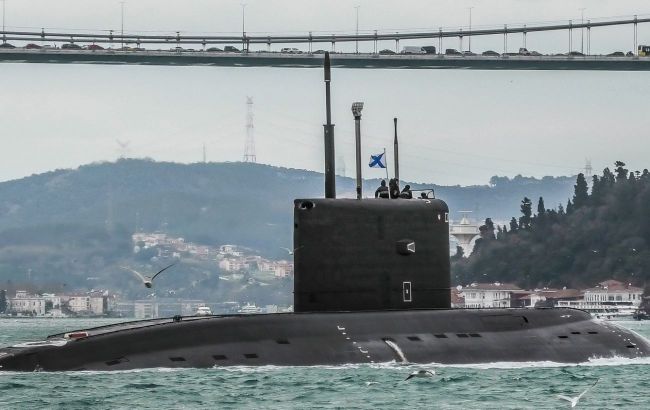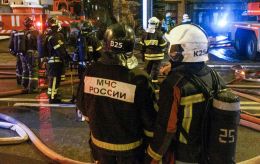Rostov-on-Don goes down. How Ukraine could have sunk Russian submarine
 Russian submarine Rostov-on-Don went down in Sevastopol (photo: x.com/egetulca)
Russian submarine Rostov-on-Don went down in Sevastopol (photo: x.com/egetulca)
Ukraine's defense forces successfully attacked Russian military facilities in Crimea. As a result, four launchers of S-400 Triumph air defense missile systems were destroyed, and the Rostov-on-Don submarine was finally destroyed.
Read more about this submarine and how the Defense Forces could have hit it in an RBC-Ukraine article.
Content
- What are results of latest strikes in Crimea
- What is known about Rostov-on-Don submarine and September attack
- Is Rostov destroyed now? What experts say
- How could Ukraine sink the submarine
- Will there be new strikes on Russian submarines
What are results of latest strikes in Crimea
According to the General Staff's report, on August 2, units of the Armed Forces missile forces, together with the Navy, damaged four S-400 missile launchers on the occupied peninsula.
The Rostov-on-Don submarine was also hit in the Sevastopol port.
"As a result of the hit, the boat sank on the spot," the General Staff reported.
The B-237 Rostov-on-Don (Kilo class according to NATO classification) is one of four Kilo class submarines capable of launching Kalibr cruise missiles. It was commissioned on December 26, 2014. The cost is estimated at $300 million.
Ukrainian forces first hit Rostov on September 13, 2023. Later, it was repaired and tested in the Sevastopol Bay.
"The destruction of the Rostov-on-Don once again proves that there is no safe place for the Russian fleet in Ukrainian territorial waters of the Black Sea," the military added.
What is known about Rostov-on-Don submarine and September attack
The B-237 Rostov-on-Don is a diesel-electric submarine of the Varshavyanka project 636.3. It was laid down in 2011 at the Admiralty Shipyards plant in St. Petersburg, and in 2014 it was launched and assigned to the Black Sea Brigade based in Novorossiysk.
In addition, there are three other submarines of this project in the Black Sea. Together with Rostov, they have been repeatedly used to launch missile strikes against Ukraine. In particular, these submarines carry four Kalibr cruise missiles each.
Other characteristics:
- displacement - 2350 tons (surface) and 3950 tons (submarine)
- length - 73.8 m
- beam - 9.9 m
- draft - 6.2 m
- speed - 11 to 17 knots above water (20 to 31 km/h) and up to 20 knots under water (up to 37 km/h)
- working depth - 240 m
- maximum depth - 300 m
- autonomy of navigation - 45 days
- crew - 52 people
Ukrainian forces launched the first strike on Rostov-on-Don on the night of September 13, 2023. Explosions and a fire were reported in the Southern Bay on the territory of the Ordzhonikidze Sevastopol Naval Shipyard (Sevmorzavod), as well as in the Kilen-Balka area, where the 13th ship repair plant is located.
Later, the Ukrainian side claimed a strike by Storm Shadow air-launched cruise missiles. As a result, the large landing ship Minsk was destroyed. However, the destruction of the submarine by a cruise missile was truly unique, not only for Ukraine but in the history of military operations.
Is Rostov destroyed now? What experts say
Experts interviewed by RBC-Ukraine agree that it is 100% certain that the Rostov was destroyed.
According to Volodymyr Zablotskyi, a naval expert at Defence Express, the submarine was almost destroyed back in September. When the Storm Shadow hit the bow, it pierced the entire ship and exploded in the stern system, causing a fire and two holes.
"At the time, she was in dry dock and could not sink. She was dragged to the 13th shipyard for repairs. Repair is a rather difficult task, but since Russia built it itself, there are spare parts available. They replaced what was destroyed inside, and almost a year later they conducted tests," he said in a comment to RBC-Ukraine.
According to him, the Russians actually simplified the task of the Defense Forces by launching the submarine.
"It was going back and forth inside Sevastopol Bay by itself. I don't know whether it was submerged or not, but it got its way and sank forever. Even if it can be raised, it will be very difficult to restore it. All the electronics and all the cables were destroyed by water. We can say that the case of Rostov's destruction has been brought to its logical conclusion," he added.
Oleksandr Kovalenko, a military and political observer at the Information Resistance group, emphasizes that the missile strike in September 2023 knocked the submarine out. And all attempts to restore the vessel were most likely not without corruption schemes.
"But for me, the most important thing is that Sevastopol and again an important facility where restoration work was being carried out was successfully struck. And at the same time, as always, "Russian air defense worked 100%," Kovalenko sneers.
In his opinion, the fact that the strikes on Crimea continue successfully and effectively is much more important than the submarine's defeat.
How could Ukraine sink the submarine
The destruction of Rostov-on-Don coincides with massive attacks on Russian facilities in occupied Crimea. In particular, on the night of August 2, explosions were reported in Sevastopol, Balaklava, Saki, Yevpatoria, and Simferopol.
Representatives of the occupation "administration" claimed a drone attack and a missile strike on Sevastopol. Local gauleiter Mykhailo Razvozhayev claimed that a part of an ATACMS ballistic missile allegedly pierced the roof of a nine-story building.
Kovalenko believes that the version that the Rostov could have been sunk by an ATACMS missile is quite plausible.
"Especially since a video was published the day before showing how these missiles were launched towards Crimea. Of course, there is no verification of when the video was made. But in principle, yes. ATACMS are exactly the missiles against which Russian air defense systems are almost helpless," he told the publication.
In turn, Zablotskyi believes that the attack was most likely a combined one. He doubts that the submarine was sunk by an ATACMS missile.
"It's unlikely because the ATACMS cluster missile is more designed to hit airfields, concentrations of equipment and infantry. And this is a point target. Therefore, I believe it was a cruise missile," the expert said.
Will there be new strikes on Russian submarines
Today it is difficult to say whether Ukraine will continue to methodically destroy submarines of the Russian Black Sea Fleet. This is also because they are based in Novorossiysk, not in the ports of Crimea.
"They can enter Crimean ports, but not for long. Staying longer than a day is a suicide. In addition, the Russians will minimize the surface position of the submarines when they are performing missions at sea. This is to minimize the risk of being hit not only by missile weapons but also by heavy drones," explains Oleksandr Kovalenko.
It is possible that in some time the submarines will be transferred from their main base in Novorossiysk to Abkhazia, where the construction of a naval base is being completed. Moreover, the declared range of the Kalibr missiles exceeds 2,000 kilometers and they are launched at Ukraine even from the Caspian Sea.
"Although I see no reason why naval drones cannot attack the base in Abkhazia. This is the occupied territory of Georgia, so I don't think such strikes can be a problem for us," the source said.
In addition to the three Varshavyanka project vessels, there is also an Alrosa project submarine in the Black Sea, which is also allegedly capable of launching Kalibr missiles. But this is not confirmed, emphasizes Volodymyr Zablotskyi.
As for the capability to destroy other submarines, there are many factors to consider.
"I assume that they can be hit, but they are unlikely to enter Crimea. They have a special base in Novorossiysk, they hide, re-moor every hour, and change their anchorages. But perhaps we simply have nothing to hit them with or our Western partners do not allow us to," the expert says.
Novorossiysk is the largest port in the Black Sea and is used to ship oil.
"The base is practically inside the city. If you strike it, it will burn for a very long time. If I were our leadership, I would strike that base. But with what? Only with drones. The latest examples from the Tuapse refinery showed that the facilities there are uncovered, as they have pulled all the air defense to Crimea. And yes, of course, the Russians are actively using Kalibr carriers, and I think submarines should be our priority target," Zablotskyi added.
Sources: statement of the General Staff of the Armed Forces of Ukraine, comments of military experts Oleksandr Kovalenko and Volodymyr Zablotskyi.

